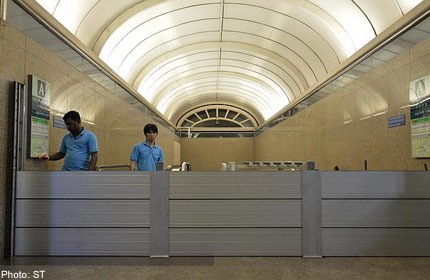First MRT stations equipped with flood barriers

SINGAPORE - With storms likely to occur more often in future, the authorities have started equipping MRT stations with flood barriers.
The first six have been retrofitted at a cost of $2.2 million, with barriers similar to those used in Hong Kong's MTR stations. Design works for another 11 stations are ongoing, said a Land Transport Authority (LTA) spokesman.
The first batch of stations - Tanjong Pagar, Orchard, Raffles Place, City Hall, Novena and Little India - were selected as they are more vulnerable to flooding, said SMRT director for media and marketing communications Alina Boey.
In its Code of Practice on surface water drainage, national water agency PUB states that the underground rapid transit system must be "stringently protected against flood risks".
Aside from minimising the storm catchments of underground MRT stations, it said integrated watertight barriers at least 1m above flood and ground levels should be used to protect underground stations and tunnels.
MRT stations already have elevated entrances to guard against flooding, but the barriers add another layer of protection.
While no MRT station has ever been flooded, Singapore has been seeing more flash floods over the past few years, caused by heavy, intense bouts of rainfall.
The National Environment Agency said last month that very heavy storms in Singapore are likely to become more frequent and intense if global temperatures rise.
The flood barriers at the six stations range from 1m to 1.5m in height, and have been tested to ensure they are watertight. It takes two people up to 15 minutes to install them.
Smaller, swing-type barriers have been installed at station plant rooms that house equipment such as condenser units, and vent shafts, glass panels and other openings have also been sealed.
Ms Boey said SMRT relies on the PUB's flood-alert system, which sends an SMS alert to a station that could be affected in the event of an impending flood.
The entrance where the flood barriers have been activated will be closed to commuters.
The operator is currently training its station and operations maintenance staff to set up the barriers.
The LTA spokesman said the authority opted for a manual system over an automated one because of the possibility of electricity being cut off during a flood, which would prevent an automated system from functioning.
Work on the next 11 stations, which will include Somerset, is expected to begin in January and end by September next year. It will cost $5.6 million.
roysim@sph.com.sg

Get a copy of The Straits Times or go to straitstimes.com for more stories.